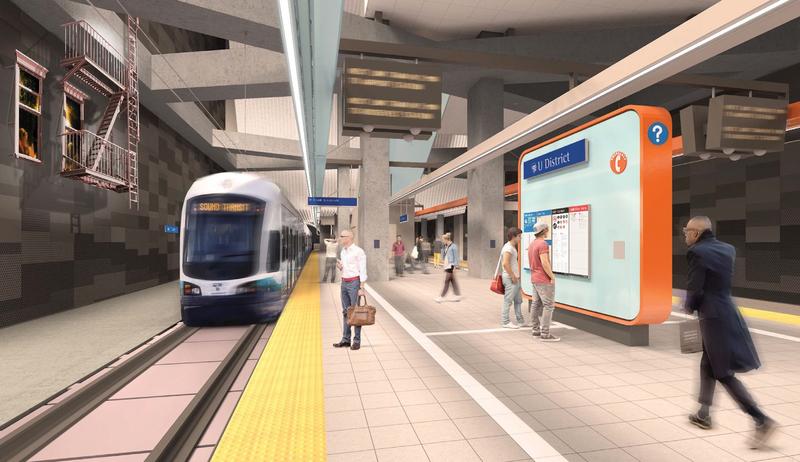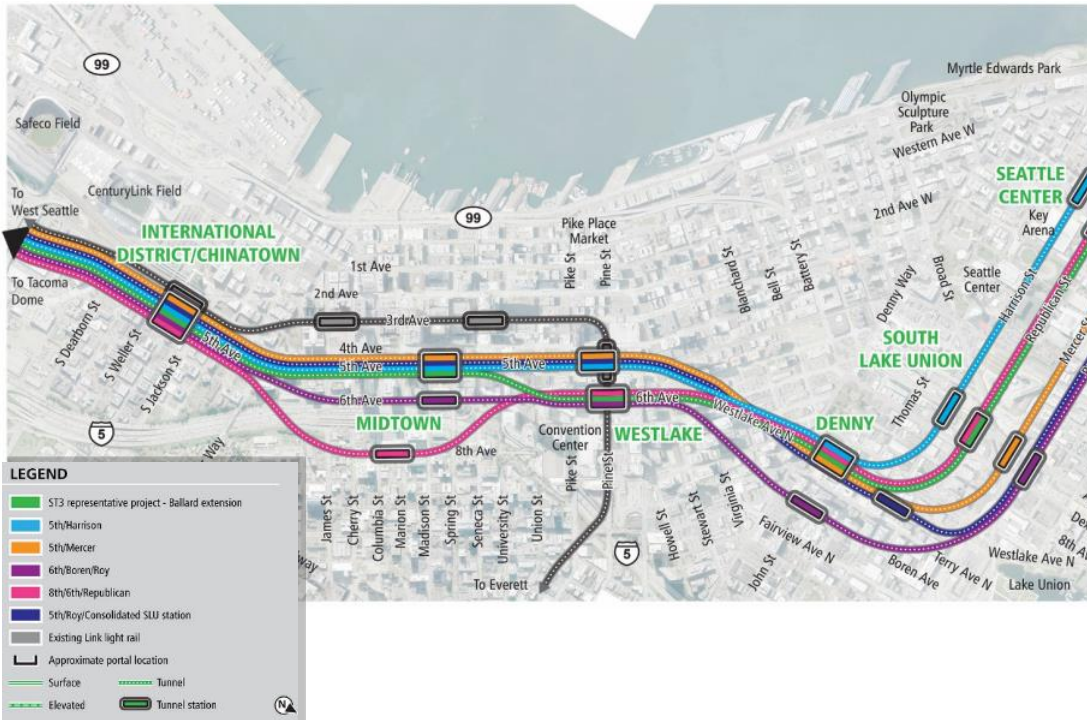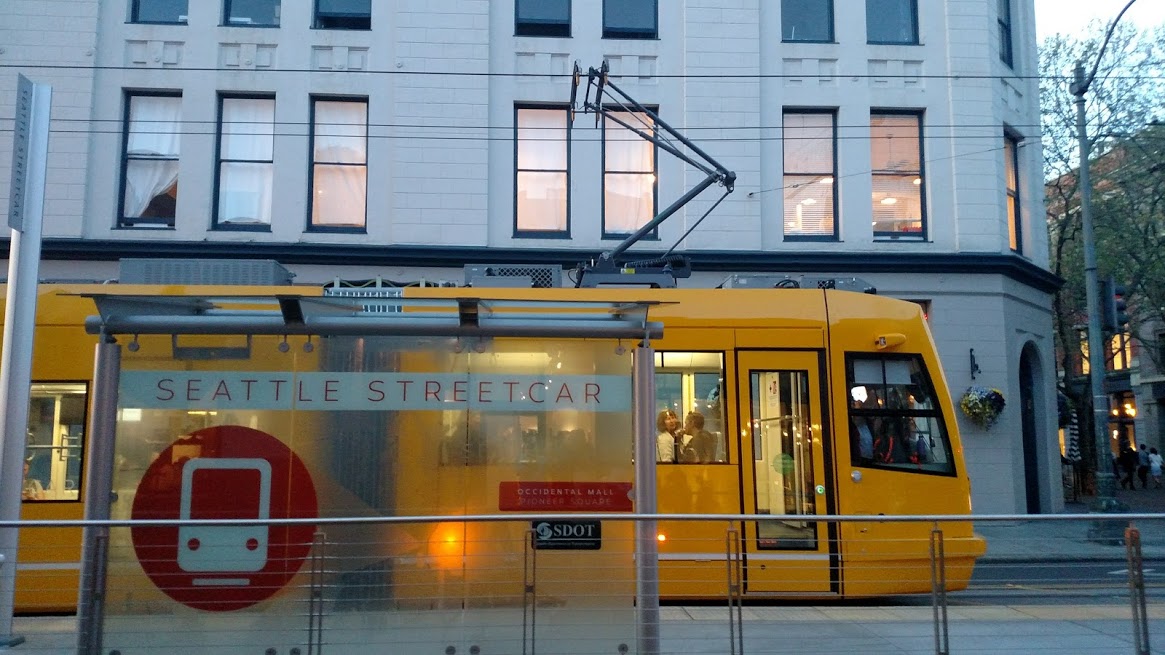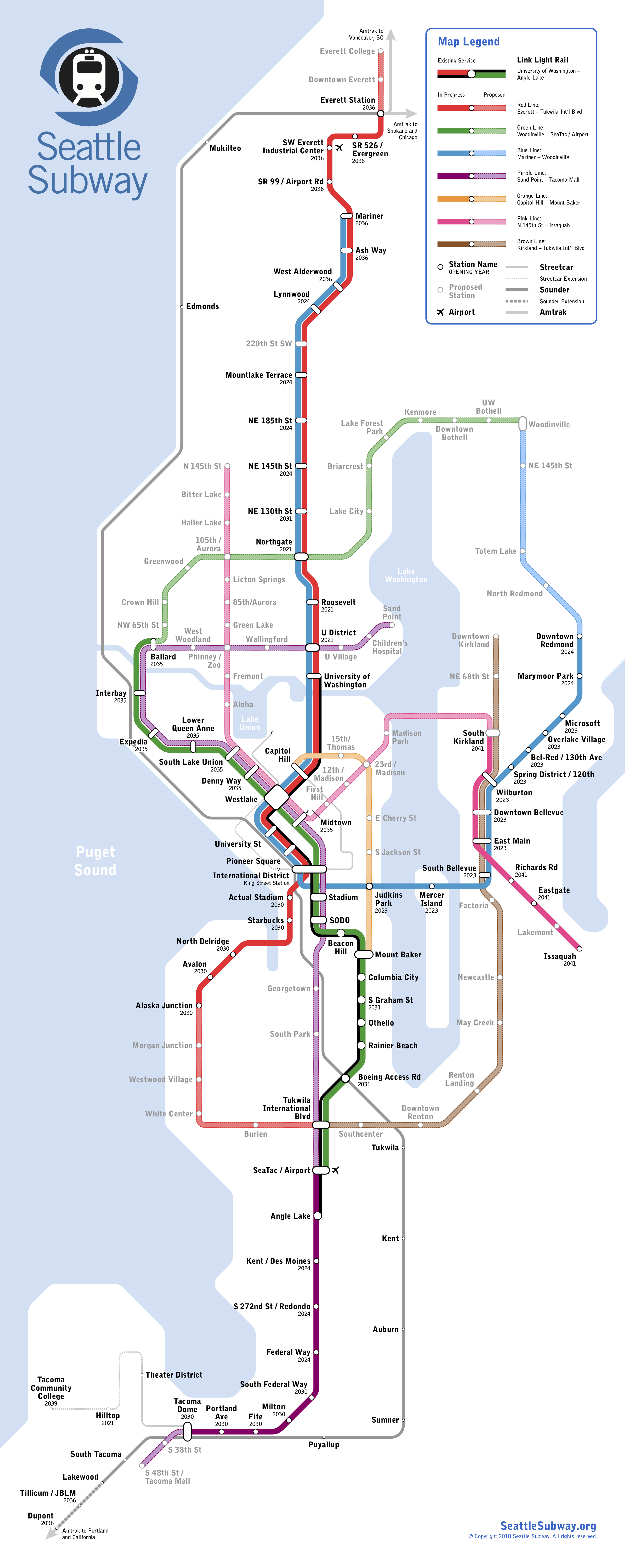
In cowardly fashion, Sound Transit couched in legalese its decision May 17th to cut First Hill from light rail consideration. Sound Transit’s lawyers alleged the agency is not even allowed to study a First Hill Station in Level 1 analysis because it’s outside the Sound Transit 3 (ST3) ballot measure‘s scope, although they did take a peek at an Eighth Avenue station, the very edge of First Hill, in Level 1 alternatives.
Transit advocates were much chagrined, watching years of advocacy made irrelevant with this newfound–and from the looks of it fishy–legal argument. Among them was Alex Hudson, First Hill Improvement Association’s executive director (and also a board member at The Urbanist).
“It’s difficult to accept that it’s not even worth studying,” Hudson said. “We’re making these really important once-in-a-generation decisions based on people’s gut feelings as opposed to analysis and data–which is how one would expect $54 billion decisions get made. We’re heartbroken.”
Hudson argued Sound Transit itself knows First Hill is an ideal neighborhood to connect to light rail and pointed to the original Sound Move plan, which had included First Hill as a station location, to illustrate her point.
“First Hill had been identified as a logical and obvious choice for high-capacity rail service by virtue of being included in the ST2 plan,” Hudson said. “That’s only gotten more clear in the Intervening years; First Hill has a 71% population growth estimated in the next five years and is the region’s major healthcare provider. So, that’s not just tens of thousands of jobs for people who are increasingly being economically displaced from the center city and are being both time and financially burdened by ever longer commutes, but it’s about basic access to care.”

Much of First Hill is zoned for 30-plus-story buildings (and will get taller still under MHA), and dozens of big projects like the iconic towers like the leaning twin towers planned across from the Frye Art Museum are on the way. Few places getting light rail in ST3 have zoning that is as friendly for dense transit-oriented development as First Hill does.
The decision to cut First Hill from ST3 is even harder to accept given how First Hill has jumped through the hoops laid before them.
“We believe that the First Hill community has been doing everything right that our agencies and our government asked us to do. We’ve not just been accepting of but we have been active proponents for affordable housing. We’ve not just been tolerant but we’ve been active proponents of mobility that doesn’t center the single-occupant vehicles. We have been laying that groundwork for the kind of community that would be a natural and obvious place for this kind of investment. It’s flabbergasting to me that we don’t even warrant a study when it’s so clear that agencies understand we should have a station, since they had originally planned on having one.”
One example of First Hill affordable housing support was its advocacy to transfer an underused Sound Transit site to affordable housing providers at zero cost, which advanced Seattle’s first affordable highrise in 50 years.
A Broad Coalition for First Hill Rapid Transit
First Hill marshaled an impressive show of support for light rail.
“We want to have questions answered about the process,” Hudson said. “The process for these decisions was that the stakeholder advisory groups, who were group of people who were hand selected by the agency, were to make recommendations about refinements in the alternative options. That process was also marked by open houses and neighborhood forums. All of which recommended First Hill move in to the next level of study. The stakeholder advisory group did so. Four out of four groups at the neighborhood forum for the Midtown Station said the Midtown station should go to First Hill. Ten out of 14 people who gave testimony at the elected leadership group were there specifically to talk about First Hill. We had many editorials including the Downtown Seattle Association–who arguably had something they were losing there–advocating for the First HIll Station. We just have some questions about the process there.”
Even with their process questions, advocates in First Hill see the writing on the wall.
“It’s clear to us that the decision has been made,” Hudson said. “It’s not moving forward.”
First Hill’s need for high capacity transit doesn’t stop just because it was passed over, Hudson said, adding they will keep fighting.
“We see it as a success that we’ve gotten First Hill back in the conversation. We’ll be working hard partners across the agencies and at all levels of government to make sure that people who live and work and who come to First Hill for education and for care are able to be connected to the region in a meaningful way.”
Streetcar Upgrades in Limbo and Madison RapidRide Delayed
Unfortunately, First Hill’s transit alternatives are lacking, especially as questions linger about the Madison RapidRide and whether it will be built to bus rapid transit (BRT) standards or be watered down and/or delayed once more.

“Our consolation prize, the First Hill Streetcar, clearly suffers from inefficiencies that clearly need to be addressed. The Madison BRT is now significantly underfunded and delayed. Those promises need to be delivered on,” Hudson said. “There are also fundamental design improvements that we want to see to ensure the connection between the Midtown area of Downtown and First Hill is as seamless and as friendly as possible. We want to see better investments in our streetcar, in our rubber-tire transit, and in the ability for people who are walking and biking to get from the transit in downtown to First Hill.”
Citing budget overrun worries, Mayor Jenny Durkan has paused construction on the Center City Connector streetcar, which would have increased frequency and added more connectivity for the First Hill Streetcar, to which it’d connect and through route. The Center City Connector being in limbo also complicates the Madison’s RapidRide G Line, which is already pushed back from its original 2019 service target to 2021.
Fighting to Preserve Bus Service on James Street
First Hill seems to have to fight just to maintain what they have. Last year, King County Metro Transit pushed to move bus service (via Route 3 and 4) from James Street to Yesler Way, hoping to shave minutes from the routes, but opponents were able to block that move.
“King Count Metro had proposed to move the 3 and the 4 because James Street is so congested, and that’s a mode choice that prioritizes cars over buses, which is surprising coming from a bus agency,” Hudson said.
Buses are carrying the load in First Hill but traffic congestion can make the routes very slow.
“First Hill is lucky. We do have quite a significant investment in bus service here, and we’re grateful to the agencies for recognizing the need here, both in terms of the jobs and the fact this a neighborhood that has the lowest rate of car ownership of anywhere in the city,” Hudson said. “We have a much higher than average rate of people who are economically transit-dependent. So we’re grateful for the investments that exist, but I’m surprised we have to continue to fight to make that case.”
The sluggishness of transit is a weight on community residents and businesses.
“I hear from our employers that the time it takes to First Hill presents a retention and recruiting problem to get and keep their high-quality employees,” Hudson said.
Right now people commuting to First Hill from outside Seattle’s core have to commute to Downtown Seattle and wait for a second bus, which tends to get bogged down in I-5 ramp traffic. Alternatively, able-bodied folks can walk from Downtown, hoofing it up the hill and weaving through Freeway Park if they know the way.
“We have to understand how we’re going to be able to connect people [to First Hill],” Hudson said. “It simply cannot be cars. We’re drastically over-congested and simply out of parking.”
Soil Conditions
The reason Sound Transit gave for cutting First Hill Station from the University Link Extension in 2005 was the soil conditions would not allow it. However, soil conditions should not deter the agency from bringing a station to First Hill Station going forward, Hudson argued.
“What I find frustrating is this discussion of soil conditions, which had been used to cancel the original light rail station, and I’m learning more and more about that process and whose studies of the soil conditions were actually used in making that argument,” Hudson said. “There’s a big story there for somebody to take a look at.”
Even accepting Sound Transit’s soil condition argument from 2005, the location now under consideration is a whole different part of First Hill.
“The original station was at Madison and Boylston; We were here talking about Madison and Eighth Avenue and that’s almost three-quarters of a mile away,” Hudson said. “If you’re saying the soil condition at Boylston are comparable at Eighth, then you’re saying they’re comparable at Fifth [where Sound Transit is recommending the Midtown Station.] I don’t necessarily know that’s a conclusion one could draw, and again we would have needed to study that in order to know it.”
Another justification given for not putting a ST3 station in First Hill is that crossing the I-5 trench twice would be expensive and present too much engineering risk.
“It’s almost like we should stopping making our regional transit and transportation decisions based on the interstate freeway for our dense growing city,” Hudson said.
And if it’s causing so much trouble maybe it’s time to think about Removing I-5 Downtown or seriously re-imagining it?
The Magenta Line
I asked Hudson what she thought of the proposal by Seattle Subway and yours truly to build an additional rapid transit line to serve First Hill, potentially elevated and turning north along Aurora Avenue.
“First Hill deserves real high capacity transit, and it’s clear at-grade service doesn’t meet our community’s needs,” Hudson said. “So we are and have been an innovative and imaginative neighborhood willing to take a look at anything that provides the connections necessary to connect people to housing and jobs in our community.”

Seattle Subway has also suggested that the second downtown transit tunnel planned in ST3 could be designed so that it could serve a later addition to First Hill, likely branching northeast from the Midtown Station. This is one thing Sound Transit can still do to at least make it easier to serve First Hill in the future.
In the interim as ST3 service appears out of the question, First Hill is willing to think outside of the box and work with the more limited resources it has available.
“One thing I don’t think we’d be interested is this idea of an underground funicular connecting First Hill to Midtown Station,” Hudson said, pointing to inherent challenges. “I would like to see the agency show a consistent ability to keep escalators or elevators running before we consider things like an underground funicular. So that one’s a tough for us, but sure whatever we need to get people to the opportunities here in this neighborhood.”
A Faster Metro Plan: Fund E Rail with City Transportation Authority
Doug Trumm is publisher of The Urbanist. An Urbanist writer since 2015, he dreams of pedestrian streets, bus lanes, and a mass-timber building spree to end our housing crisis. He graduated from the Evans School of Public Policy and Governance at the University of Washington in 2019. He lives in Seattle's Fremont neighborhood and loves to explore the city by foot and by bike.


